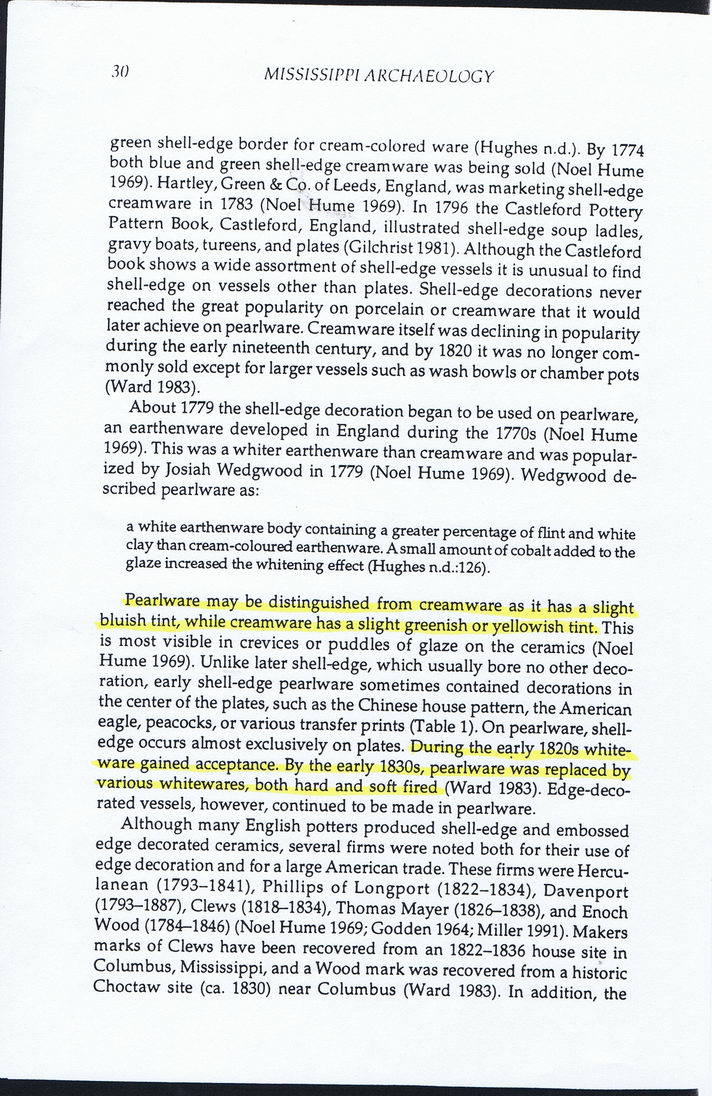This text was obtained via automated optical character recognition.
It has not been edited and may therefore contain several errors.
30 MISSISSIPPI ARCHAEOLOGY green shell-edge border for cream-colored ware (Hughes n.d.). By 1774 both blue and green shell-edge creamware was being sold (Noel Hume 1969). Hartley, Green & Co. of Leeds, England, was marketing shell-edge creamware in 1783 (Noel Hume 1969). In 1796 the Castleford Pottery Pattern Book, Castleford, England, illustrated shell-edge soup ladles, gravy boats, tureens, and plates (Gilchrist 1981). Although the Castleford book shows a wide assortment of shell-edge vessels it is unusual to find shell-edge on vessels other than plates. Shell-edge decorations never reached the great popularity on porcelain or creamware that it would later achieve on pearlware. Creamware itself was declining in popularity during the early nineteenth century, and by 1820 it was no longer commonly sold except for larger vessels such as wash bowls or chamber pots (Ward 1983). About 1779 the shell-edge decoration began to be used on pearlware, an earthenware developed in England during the 1770s (Noel Hume 1969). This was a whiter earthenware than creamware and was popularized by Josiah Wedgwood in 1779 (Noel Hume 1969). Wedgwood described pearlware as: a white earthenware body containing a greater percentage of flint and white clay than cream-coloured earthenware. A small amount of cobalt added to the glaze increased the whitening effect (Hughes n.d.:126). Pearlware may be distinguished from creamware as it has a slight bluish tint, while creamware has a slight greenish or yellowish tint. This is most visible in crevices or puddles of glaze on the ceramics (Noel Hume 1969). Unlike later shell-edge, which usually bore no other decoration, early shell-edge pearlware sometimes contained decorations in the center of the plates, such as the Chinese house pattern, the American eagle, peacocks, or various transfer prints (Table 1). On pearlware, shell-edge occurs almost exclusively on plates. During the early 1820s white-ware gained acceptance. By the early 1830s, pearlware was replaced by various whitewares, both hard and soft fired (Ward 1983). Edge-decorated vessels, however, continued to be made in pearlware. Although many English potters produced shell-edge and embossed edge decorated ceramics, several firms were noted both for their use of edge decoration and for a large American trade. These firms were Hercu-lanean (1793-1841), Phillips of Longport (1822-1834), Davenport (1793-1887), Clews (1818-1834), Thomas Mayer (1826-1838), and Enoch Wood (1784-1846) (Noel Hume 1969; Godden 1964; Miller 1991). Makers marks of Clews have been recovered from an 1822-1836 house site in Columbus, Mississippi, and a Wood mark was recovered from a historic Choctaw site (ca. 1830) near Columbus (Ward 1983). In addition, the

Poverty Point (Indian Culture) Shell-edge Decorated Ceramics - Rufus Ward (04)